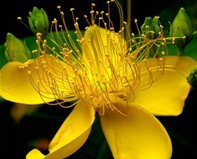Hypericum is a genus of about 400 species of flowering plants in the family Hypericaceae (formerly often considered a subfamily of Clusiaceae).
The genus has a nearly worldwide distribution, missing only from tropical lowlands, deserts and polar regions. All members of the genus may be referred to as St. John's wort, though they are also commonly just called hypericum, and some are known as tutsan. Hypericum perforatum is the most potent species and it is today grown commercially for use in herbalism and medicine; other St. John's-worts possess interesting properties and chemical compounds but are not well researched. As these secondary compounds appear to be related to deterring herbivores, they are present in varying and unpredictable quantities: still, a number of high-yield cultivars have been developed.
Two main compounds of interest have been studied in more detail: hyperforin and hypericin.
| Catalog | Product Name | CAS Number | Manual |
|---|---|---|---|
| CFN98754 | Hyperoside | 482-36-0 | |
| CFN99188 | Hypericin | 548-04-9 | |
| CFN99591 | Pseudohypericin | 55954-61-5 | |
| CFN99728 | 2''-O-Galloylhyperin | 53209-27-1 | |
| CFN98834 | Emodin | 518-82-1 | |
| CFN98753 | Isoquercitrin | 482-35-9 | |
| CFN99642 | Rutin | 153-18-4 | |
| CFN99584 | Methyl hesperidin | 11013-97-1 | |
| CFN99272 | Quercetin | 117-39-5 | |
| CFN98850 | Quercitrin | 522-12-3 | |
| CFN98754 | Hyperoside | 482-36-0 |
A unique collection of 69 natural compounds from Morus alba L.
A unique collection of 21 natural compounds from Saussurea lappa Clarke
A unique collection of 22 natural compounds from Tamarix chinensis Lour
A unique collection of 21 natural compounds from Angelica dahurica(Fisch.et Hoffm.)Benth.et Hook.f.ex Franch.et Sav.cv.Hangbaizhi Hort.
A unique collection of 21 natural compounds from Celastrus orbiculatus Thunb





